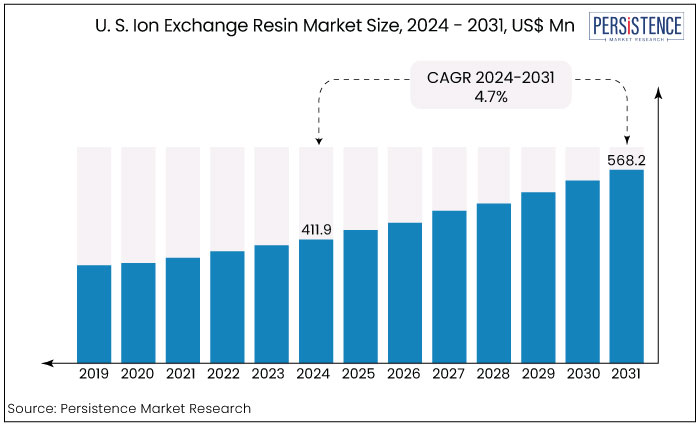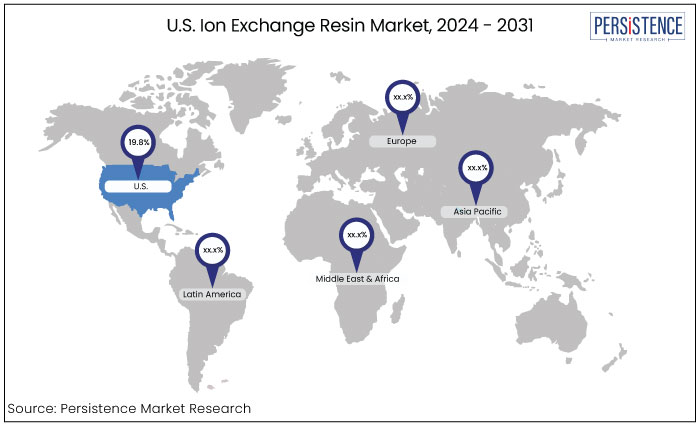U.S. Ion Exchange Resin Market
Industry: Chemicals and Materials
Published Date: October-2024
Format: PPT*, PDF, EXCEL
Delivery Timelines: Contact Sales
Number of Pages: 172
Report ID: PMRREP34849
The U.S. ion exchange resin market is estimated to increase from US$411.9 Mn in 2024 to US$568.2 Mn by 2031. The market is projected to record a CAGR of 4.7% during the forecast period from 2024 to 2031. The market is driven by environmental regulations, high-purity water demand, and the shift toward eco-friendly resin options.

Key Highlights of the Market
|
Market Attributes |
Key Insights |
|
U.S. Ion Exchange Resin Market Size (2024E) |
US$ 411.9Mn |
|
Projected Market Value (2031F) |
US$ 568.2Mn |
|
Global Market Growth Rate (CAGR 2024 to 2031) |
4.7% |
|
Historical Market Growth Rate (CAGR 2019 to 2023) |
3.2% |
|
Category |
CAGR through 2031 |
|
Application - Water |
6.12% |
The water segment is expected to become a leading category in the U.S. ion exchange resins market, commanding a substantial share. It is projected to experience a CAGR of 6.12% in during the period from 2024 to 2031. These versatile resins are integral to various water treatment processes including softening, deionization, demineralization, and disinfection.
Ion-exchange resins present an economical solution for purifying and decontaminating ionic compounds making them essential in water applications. The unique property of reversibility allows these resins to be regenerated simply by using solutions rich in displaced ions. Moreover, they effectively soften highly acidic or alkaline waters, producing water with minimal hardness.
|
Category |
CAGR through 2031 |
|
End Use - Water and Wastewater Treatment |
6.58% |
The water and wastewater treatment segment is predicted to dominate the U.S. ion exchange resins market in 2024 capturing the significant market share. This segment is anticipated to expand at a CAGR of 6.58% during the period from 2024 to 2031.
While water softening remains the most recognized application, ion exchange resins serve many additional purposes such as mitigating harmful substances like arsenic, nitrates, uranium, and perchlorate. This capability is crucial for producing high-quality deionized and demineralized water.
The increasing demand for ion-exchange resins is further fueled by various initiatives to enhance water infrastructure. For instance, in July 2021, the USDA allocated US$307 million across 34 states and Puerto Rico to modernize rural water systems. These efforts are significantly propelling the growth of the water and wastewater treatment sector, further boosting the demand for ion-exchange resins.
The U.S. ion exchange resin market overview shows that the market has grown continuously in the past few years, and it is expected to grow further. Ion exchange resins are synthetic polymer beads that facilitate the exchange of ions in a solution, playing a crucial role in various water treatment processes, chemical manufacturing, and pharmaceuticals.
The primary applications of ion exchange resins include water purification, demineralization processes, and as catalysts in chemical reactions. Their versatility makes them invaluable in industries ranging from power generation and food processing to pharmaceuticals and electronics.
The sector is currently experiencing significant growth driven by increasing environmental regulations and the rising demand for high-purity water across various sectors. One of the most prominent market trends is the shift toward more eco-friendly and sustainable resin options as industries seek to reduce their ecological footprint.
Advancements in resin technology, such as the development of high-capacity and selective resins, are enhancing efficiency and effectiveness in applications like wastewater treatment and drinking water purification. The market is also witnessing a growing emphasis on resin regeneration services, allowing companies to extend the lifespan of their products and reduce costs.
The rise of the pharmaceutical and biotechnology sectors is propelling demand for specialized ion exchange resins tailored for specific applications indicating a trend toward customization and innovation in resin production. As the market evolves, these trends reflect a broad commitment to sustainability and efficiency positioning ion exchange resins as essential in the quest for clean, and safe industrial processes.

The U.S. ion exchange resin market analysis has highlighted noteworthy growth over the past few decades driven by increasing industrial applications and advancements in resin technology. The development of these resins is a significant milestone enhancing the efficiency of water demineralization processes and expanding the scope of applications in various sectors, including pharmaceuticals and food processing.
As industries began to recognize the importance of water quality and purity, the demand for ion exchange resins surged, leading to innovations that improved resin performance and longevity. In recent years, the market has continued to evolve influenced by strict environmental regulations and a growing emphasis on sustainability.
The shift toward eco-friendly practices has prompted manufacturers to develop resins that not only meet performance standards but also minimize environmental impact. This trend is expected to accelerate as industries increasingly adopt circular economy principles, focusing on resin regeneration and reuse to reduce waste and costs.
The U.S. ion exchange resin market opportunities look promising and poised to fuel the industry growth. The market is expected to attain CAGR of 4.7% during the period from 2024 to 2031. The ongoing expansion of the pharmaceutical and biotechnology sectors will likely drive demand for specialized resins tailored for specific applications, such as drug purification and water treatment.
Advancements in resin technology, including the development of high-capacity and selective resins, will enhance operational efficiency and effectiveness in various applications.
Increasing Demand for Water Purification
The rising need for clean and safe drinking water is a significant growth driver in U.S. ion exchange resin market. Urbanization, population growth, and industrial activities have led to the contamination of water sources, creating a pressing demand for effective water treatment solutions.
Ion exchange resins are essential in removing impurities, including heavy metals and hardness-causing ions, making them vital for municipal water treatment facilities and residential applications. As regulatory standards for water quality become stricter, the demand for ion exchange resins is expected to continue growing.
Expanding Pharmaceutical and Biotechnology Sectors
The rapid expansion of the pharmaceutical and biotechnology industries is another crucial growth driver for the U.S. ion exchange resin market expansion. These sectors require high-purity water and specialized resins for various applications, including drug formulation, purification, and separation processes.
Ion exchange resins facilitate the removal of contaminants and ensure the quality of pharmaceutical products. As research and development in these industries intensify, the demand for customized ion exchange resins tailored to specific applications will increase, further propelling market growth.
Stringent Environmental Regulations
Stringent environmental regulations aimed at reducing water pollution and improving waste management practices are significantly driving the U.S. ion exchange resin market growth. Regulatory bodies are enforcing stricter standards for wastewater treatment, compelling industries to adopt advanced purification technologies.
Ion exchange resins play a crucial role in meeting these compliance requirements by effectively removing harmful contaminants from wastewater before discharge. As industries strive to align with environmental policies and corporate sustainability goals, the demand for efficient and eco-friendly ion exchange resin solutions is expected to rise.
High Initial Investment Costs
One of the significant factors impeding the growth of U.S. ion exchange resin market is the high initial investment required for ion exchange systems. The setup costs for purchasing and installing ion exchange equipment can be substantial, particularly for small to medium-sized enterprises.
This financial barrier can deter potential users from adopting ion exchange technology, especially when alternative water treatment methods may appear more cost-effective in the short term. As a result, the reluctance to invest in these systems can slow market expansion and limit the adoption of ion exchange resins.
Competition from Alternative Technologies
The U.S. ion exchange resin market is hindered by stiff competition from alternative water treatment technologies, such as reverse osmosis and activated carbon filtration. These methods often provide effective solutions for water purification and can be perceived as more straightforward or less costly to implement.
As industries and municipalities explore various treatment options, the preference for these alternatives can hinder the growth of ion exchange resin applications. Additionally, advancements in competing technologies may further challenge the market, as they offer innovative solutions that could overshadow traditional ion exchange processes.
Increased Focus on Sustainable Practices
As sustainability becomes a central focus for many industries, there is a significant opportunity for the U.S. ion exchange resin market growth to innovate and provide eco-friendly solutions.
Companies are increasingly seeking to minimize their environmental impact, leading to a demand for resins that can be regenerated and reused multiple times. This shift towards sustainable practices opens avenues for manufacturers to develop advanced resins that not only perform efficiently but are also designed with environmental considerations in mind. By prioritizing sustainability, the market can attract new customers and foster long-term growth.
Technological Advancements in Resin Development
Technological advancements present a promising opportunity for the U.S. ion exchange resin market concentration to enhance product performance and expand applications. Innovations such as the development of high-capacity and selective resins can significantly improve the efficiency of ion exchange processes, making them more attractive to industries seeking effective water treatment solutions.
Additionally, integrating smart technology and automation into resin systems can optimize operations and reduce maintenance costs. As industries increasingly rely on advanced materials and technologies, the ion exchange resin market can leverage these innovations to enhance competitiveness and drive growth.
The U.S. ion exchange resin market is characterized by intense competition among key players striving for innovation and market share. Companies like BASF SE have introduced advanced products such as Ludox, a silica-based ion exchange resin designed for high-performance applications.
Dow Inc. launched the DOWEX Ion Exchange Resins, featuring enhanced selectivity and regeneration capabilities to meet stringent water quality standards. Lanxess AG has also made strides with its Lewatit line, focusing on eco-friendly formulations. These innovations reflect the industry's commitment to providing efficient, sustainable solutions and enhancing operational effectiveness in water treatment and other industrial processes.
Recent Developments in the U.S. Ion Exchange Resin Market
|
Attributes |
Details |
|
Forecast Period |
2024 to 2031 |
|
Historical Data Available for |
2019 to 2023 |
|
Market Analysis |
US$ Million for Value |
|
Key Market Segments Covered |
|
|
Key Companies Profiled |
|
|
Report Coverage |
|
|
Customization & Pricing |
Available upon request |
By Product Type
By Application
By End Use
To know more about delivery timeline for this report Contact Sales

The market is predicted to rise from US$ 411.9 Mn in 2024 to US$ 568.2 Mn by 2031.
DuPont, Sodick, Jacobi Carbons, and ResinTech Inc. are some companies in this industry.
The water and wastewater treatment is leading segment and is predicted to dominate the 2024 market with a CAGR of 6.58% from 2024 to 2031.
The U.S. is the leading segment and is projected to account for 19.8% of the global market by 2031.
Key opportunities in this industry include the increasing environmental regulations and the rising demand for high-purity water.